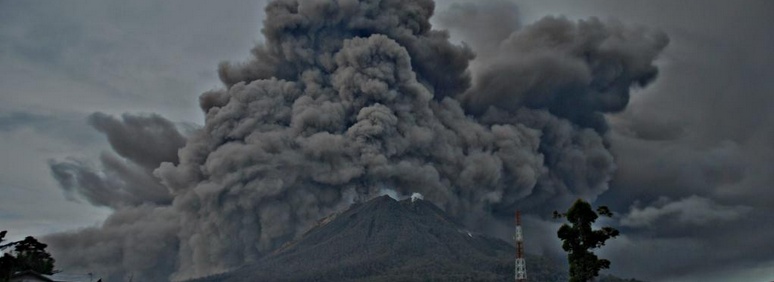Strong eruption and large pyroclastic flow at Sinabung volcano, Indonesia

A significant eruption of Indonesian Mount Sinabung took place around 00:00 UTC on January 3, 2015, according to Darwin VAAC.
Although volcanic ash was not identified on satellite imagery, Aviation Color Code has been raised to Red.
A large pyroclastic flow followed today's eruption.
Need Masker pic.twitter.com/MpfD7qGWrK
— Sinabung Volunteers (@Sinabung_V) January 3, 2015
Visual #Sinabung dari Berastagi pic.twitter.com/3O1KZIkE4v
— Sinabung Volunteers (@Sinabung_V) January 3, 2015
Mt. #Sinabung erupting in Indonesia on Saturday. 1/3/2015. Via @infoVolcano pic.twitter.com/ghniqRdpjN
— Mike Hamernik (@MikeHamernik) January 3, 2015
#SINABUNG Jan 3, 2014 – 07:30am Pyroclastic flow taken from Kutarayat by Satar GS @BeidarSinabung @infobencana pic.twitter.com/HMxIHnJsez
— Volcano Alert (@infoVolcano) January 3, 2015
In their Volcanic Ash Advisory issued at 14:16 UTC today, Darwin VAAC said a high level of seismic activity is still being reported at the volcano.
.png)
Image credit: Darwin VAAC
The last time this volcano appeared in GVP's weekly volcanic report was during the week of December 24 – 30, 2014: "Based on satellite images, webcam views, and weather models, the Darwin VAAC reported that an ash plume from Sinabung drifted almost 30 km SW on December 24."
PVMBG reported that 53 pyroclastic flows at Sinabung occurred during December 8 – 16, 2014 and traveled as far as 4.5 km S and 1 km SE. Ash plumes rose as high as 5 km and drifted W and SW.
Since October a new lava dome had grown from the crater (on the W side of the lava tongue) and was 215 meters long. The main lava tongue was about 2 947 meters on December 15.
Geologic summary
Gunung Sinabung is a Pleistocene-to-Holocene stratovolcano with many lava flows on its flanks. The migration of summit vents along a N-S line gives the summit crater complex an elongated form. The youngest crater of this conical, 2460-m-high andesitic-to-dacitic volcano is at the southern end of the four overlapping summit craters.
An unconfirmed eruption was noted in 1881, and solfataric activity was seen at the summit and upper flanks in 1912.
No confirmed historical eruptions were recorded prior to explosive eruptions during August-September 2010 that produced ash plumes to 5 km above the summit. (GVP)
Featured image: Sinabung eruption on January 3, 2015. Image credit: ithinkx via Twitter

It’s too bad for the residents but so far this does not seem to be a problem for the world. Until the volcanic clouds hit more than 10 KM of height in the atmosphere there should be no impact on global weather.